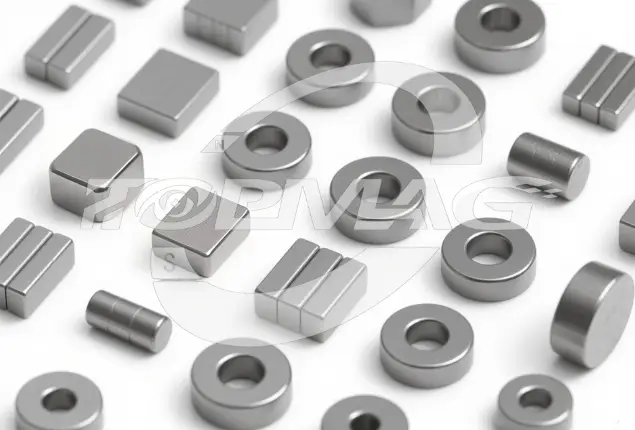Big NdFeB Magnets: Size, Performance and Customization
 Big Neodymium magnets, called industrial-grade magnets, whose side sizes are bigger than 40 mm, have become a pillar of modern technology because of their exceptional magnetic power and stability. They are stirring up industry innovation due to their excellent magnetic fields.
Big Neodymium magnets, called industrial-grade magnets, whose side sizes are bigger than 40 mm, have become a pillar of modern technology because of their exceptional magnetic power and stability. They are stirring up industry innovation due to their excellent magnetic fields.
Standard big sizes of Neodymium magnets are 40x40x20 mm, suitable for small motors or experimental purposes. Regarding industrial applications, other standard sizes are disk shape – 300×40 mm, block – 250x100x40 mm, and cube – 100x100x100 mm. With such excellent dimensions, these magnets find their application in wind turbine rotor assemblies, drive motors for electric vehicles, and considerable magnetic drum equipment. They also increase energy conversion efficiency and save costs when assembling smaller magnets.
Big Neodymium Magnets have different modifications regarding their intended use. Purchasers can determine the desired magnetization direction and coating type for enhanced corrosion protection. Usually, the customization involves magnetic field simulation to allow the magnets’ shape and size to form optimal performance in a given application.
Suppliers and Services

We offer our full support, starting from the manufacturing process and ending with the delivery to the customers, so that the magnets are made per the requirements. Purchasers can contact us to get the latest prices and stock to make buying more efficient.
To meet diverse customer needs, TOPMAG offers a range of customizable options for our neodymium magnets, including size, grade, coating, magnetization direction, and dimensional tolerances.
1. Size
Big magnets require higher concentrations of rare earth elements, which are expensive due to the high mining and refining costs. A 300mm diameter disc magnet can be dozens of times more costly than a small 40mm magnet. The production of large magnets requires specialized equipment.
2. Magnet Grade
Higher-grade magnets include more rare-earth elements and have a greater magnetic energy product. They are ideal for high-performance motors or sensors. They cost much more than lower-grade magnets, like N35. The higher-temperature-series grades are the SH series, which can go 150°C without any change in magnetic properties, which means they’re inert as far as aerospace applications or industrial drying processes are concerned.
3. Coating Selection
The coating selection should be determined based on the application environment.
- Nickel plating (Ni-Cu-Ni): Highly corrosion-resistant, suitable for general environments.
- Galvanizing: Lower cost, suitable for budget-constrained applications.
- Epoxy coating: Chemically resistant, suitable for marine or acidic environments.
4. Operating Temperature
The highest operating temperature of the N series magnets is 80°C. Going beyond this temperature will result in the magnets losing their magnetization permanently. The SH, UH, or EH series should be chosen if the application is at high temperatures. Buyers need to know the temperature range of the application very clearly so that the magnet will not lose its magnetic force.
5. Magnetizing Direction
The magnetizing direction will influence the magnetic field’s distribution and the magnet’s performance. The axial direction is preferred for rotors; however, this is not always the case in other applications. In the case of custom orders, customer specifications related to the intended end application are required to ensure optimal performance is achieved.
6. Dimensional Tolerances
Typical machining tolerances on big magnets are ±0.05mm to ±0.1mm. Better tolerances increase costs. The purchaser should be clear on the accuracy requirements for the particular application and decide the importance of this parameter, thus avoiding unnecessary expenses. Generally, most precision instruments require high accuracy for many applications.
Safety Instructions
.webp)
Material Fragility: NdFeB magnets are hard and brittle; striking them can easily break them. Rapid attachment may also create sparks or fragments. Handle with care, and approach slowly with cushioning materials. Damaged magnets will influence the performance.
Transport Safety: The best way to transport big neodymium magnets is by sea freight. This is the cheapest and accommodates big orders. This also requires multilayer iron plate protection from the strong magnetic fields generated by large magnets for safety standards and international shipment. Sea freight has less stringent rules on magnetic field interference over long distances, but it takes longer to ship, about two to four weeks.

I'm dedicated to popular science writing about magnets. My articles mainly focus on their principles, applications, and industry anecdotes. Our goal is to provide readers with valuable information, helping everyone better understand the charm and significance of magnets. At the same time, we're eager to hear your opinions on magnet-related needs. Feel free to follow and engage with us as we explore the endless possibilities of magnets together!



